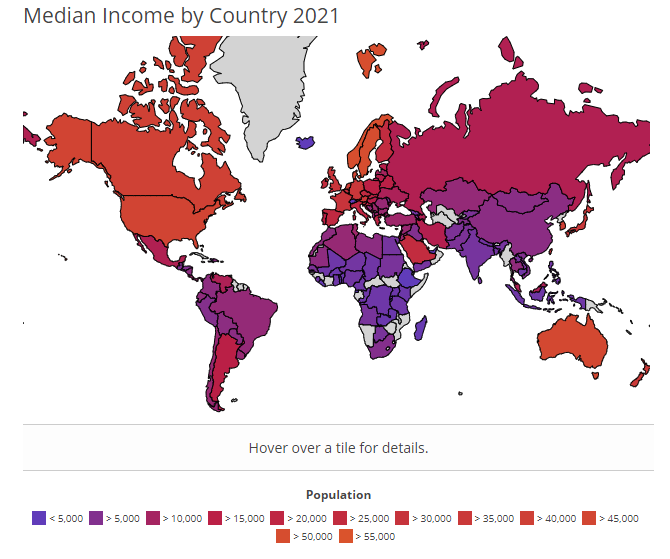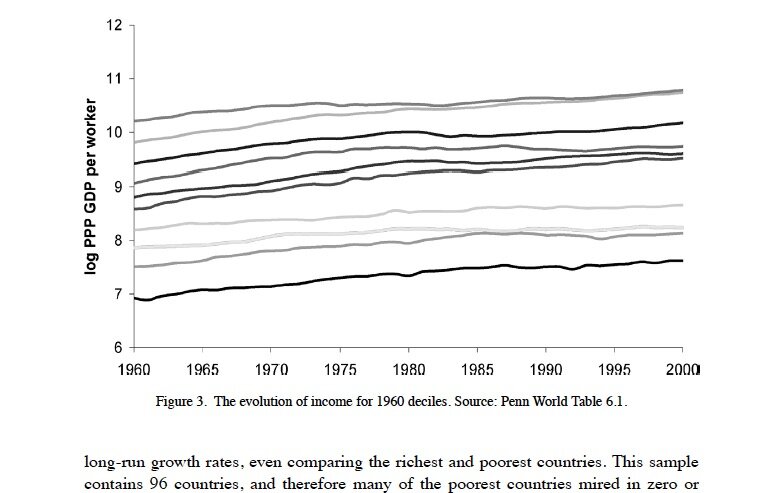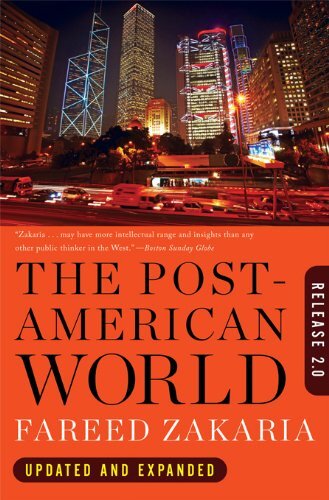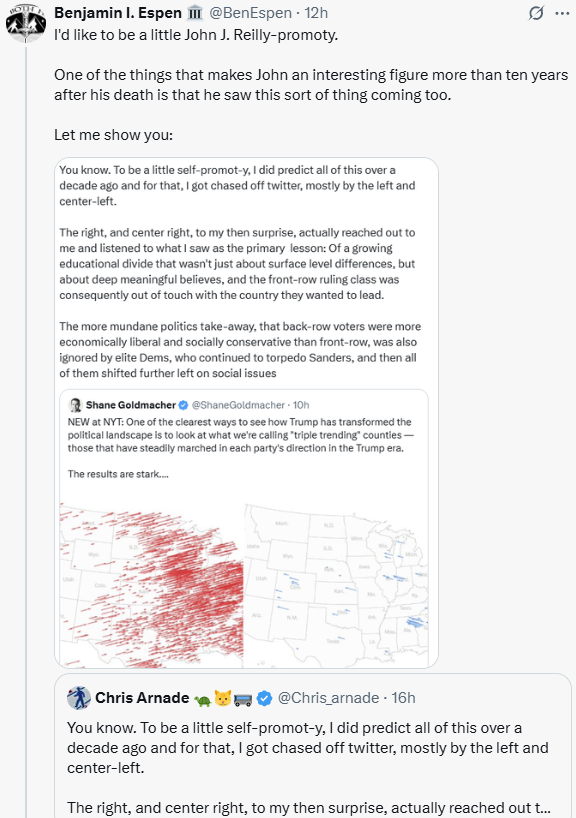The Long View: The Post-American World
This particular book review by John J. Reilly probably makes the most sense in combination with his 2003 review of Fakaria’s The Future of Freedom.
I don’t think I can improve on this assessment I made in my preamble to the 2003 review posted here at With Both Hands in 2015:
We now have twelve years more history to evaluate under Zakaria's model and see what happened.
- Russia still lacks any kind of independent civil society. The Russian Orthodox Church has tended to hew closely to the state. As predicted, a lack of independent sources of power leaves you with no option other than a good czar. Putin is still in charge.
- Attempts to instill democracy in a variety of Arab countries have failed miserably, leading to wars and a refugee crisis. Most of these states were organized on religious lines, ethnic lines, or both. Democracy has enabled clear majorities to oppress minorities, or else civil war has ensued when no one had a clear balance of power. It now seems clear that the lack of democracy in these places was a feature, not a bug. On a side note, the popularity of groups like the Muslim Brotherhood is no doubt enhanced because they *are* civil society in countries like Egypt. The Brotherhood provides many services to the people.
- America and Europe are roiled by populist movements. These gain followers precisely because of the perception that the elites that rule Western Civilization seem uninterested in anything other than their own aggrandizement.
Zakaria wanted to highlight these democratic deficiencies in order to save liberal democracy from itself. So far, it looks like this has not been effective. In fact, my suspicion is that his proffered remedies, for example more elite unaccountable agencies run by experts like the Federal Reserve, will hasten rather than retard progress towards a universal state. As such, I'm surprised by the cool tone of John's review, but maybe he was focusing on what Zakaria wanted, rather than what he is getting.
I do have some spiffy graphs to spice up the argument Zakaria makes about the rough income level needed to support a liberal democracy.
First, a link to a source of median income by country.

Second an observation by the indispensable Pseudoerasmus that almost all countries tend to grow together. So if you think that money is really the critical factor, everyone should get there eventually.

If.

The Post-American World
By Fareed Zakaria
W.W. Norton, 2008
292 Pages, US$25.95
ISBN 978-0-393-06235-9
The title of this book is not really misleading, but “the end” is not what we might at first suppose. This is not another “declinist” exercise about the coming eclipse of the United States. The author, Fareed Zakaria, currently the editor of Newsweek International, here continues to articulate some of the theses he made in his earlier work, The Future of Freedom. He particularly emphasizes that modern conditions create a tension between democracy and liberty that must be resolved in liberty’s favor. America is not even in relative decline, the author assures us: it has produced about a fifth of the global product for more than a century, and that percentage seems unlikely to change. Neither, in some respects, will America’s preeminence as a state. In The Post-American World, he argues that in the 21st century the United States must deal with the consequences of its own success. In the course of the last 150 years, American ideas and institutions have become globally predominant. For the most part, there were good and efficacious ideas. Because of them, we are seeing today “the Rise of the Rest.” The era is ending in which American-style prosperity and liberty were unique. Nonetheless, the US will naturally perform a different function in an age in which, for the first time, America resembles the rest of the planet.
The Post-American World presents a remarkably anti-apocalyptic model of history; more anti-apocalyptic even than Francis Fukuyama’s End of History, which at least had an apocalypse in the past, during the Napoleonic Wars. The magic number for the 21st century is 3,000, as in the $3,000 average annual income that a country needs for liberal institutions to become secure. (Actually, I think the author usually says “between $2,000 and $5,000,” but we’ll take $3,000 as a symbol.) Below that figure, countries with democratic institutions tend to become plebiscitary dictatorships. For such states, the author advises, the best American policy is to encourage not “democracy,” but responsible autocracy, in which market-driven economic development can occur. And in fact, in the last quarter of the 20th century, the growth-inhibiting command-economy model of development was discredited, and the American economic model was tried instead. It worked. When countries rose above that $3,000 figure, there was a middle class numerous and ambitious enough to negotiate the full menu of liberal institutions. Such countries can be held to a higher standard; for them, the American political system also becomes a model. That was the tale of East Asia and Latin America, and there is every reason to suppose that it will be the tale of the world.
So great is the power of 3K, in fact, that the ordinary considerations of statecraft have become obsolete. The goal of diplomacy really should be to keep talking forever, because time is on the side of 3K. What seem like intolerable international menaces will evaporate if we just wait long enough. This is particularly the case with the “Islamist threat.” Islamism can be no more than an annoyance, we are assured, because it does not fundamentally impede the 3K process.
Terrorism is best countered by the refusal to be terrified, says the author. Military response is usually irrelevant. So are most security measures. (The author apparently spends a lot of time in American airports; some of his remarks on that aspect of the matter are well taken.) Countries targeted by terrorism should instead cultivate resilience. Attacks cannot be wholly prevented, if malicious persons insist on making them. They will stop when it becomes clear that the damage they cause can be quickly repaired, and that they do not interfere with ordinary life.
The author does not dwell on the matter, but this model is very close to Kant’s “end of history”: a world of “liberal republics.” Such states are not necessarily democracies in the Jacksonian sense, though they can be. The essential criterion is a “transparent” political system in which the authorities can be called to account before the law, even if the calling comes from managerial elites rather than an electorate. And in fact, as we will see below, the author does believe that democracy in the narrow sense is something of an anachronism for states on the high side of the 3K boundary. But first, let us consider some of the very interesting things the author has to say about the state of the world.
When we talk about the “rising Rest” in today’s world, we are talking chiefly about China and India. The author emigrated from India to the United States in the 1980s, as an 18-year-old student, and he has quite a lot of dryly affectionate things to say about the home country, usually in comparison with China. China is below the 3K line, so it is not surprising that it is still ruled by a bureaucratic elite. (That’s an important point: the Chinese Communist Party has become a relatively small, highly selective association of technical experts.) Actually, the Chinese autocrats are good of their kind. They have the despot’s knack for making splendid infrastructure seem to appear out of the ground almost overnight; indeed, sometimes out of ground that had been occupied by tens of thousands of their subjects just a few months earlier.
India is even further below the 3K line than China, but it is a genuine democracy. This happy anomaly is an after-effect of the British Raj, which bequeathed the subcontinent a sophisticated and advantageous state structure that Indian society could not have generated indigenously. India’s problem is that its democracy makes hard decisions impossible. Government in India is usually out to lunch. The interest groups that compete in India’s democratic system somehow contrive to ensure that not enough roads are built, that the schools are dismal and the courts don’t quite work. However, they have had the wit in recent decades to relax the soft-socialist economic regime of the immediate post-independence years, with the result that hundreds of millions of Indians have moved out of primary poverty.
The author makes suitably admiring comments about the persistently enormous growth rates of the Chinese and Indian economies. He also sprinkles these remarks with helpful caveats about the fact it is not at all clear what the numbers mean: the Chinese economy in particular waxes and wanes by 40%, depending on whether you use local or world-market prices, not to mention the fact that the statistics themselves are often fabulations concocted to impress the home office. Still, some of these numbers are intriguing on several levels. By world standards, the author notes, the US federal government is a “weak state.” One indicator of this is the fact it absorbs only 70% of all tax revenues raised in the United States. Contrast this with China. The People’s Republic may be a neo-Legalist autocracy, but Beijing still contrives to cage only about 50% of the tax revenues raised in the provinces. The central government is losing its grip on society; in large part by design, but also because society is strengthening in comparison with the state.
The author does not see the constellation of the US, India, and China moving toward the kind of great-power antagonism that characterized Europe in the second half of the nineteenth century, or toward an armed multipolarity modeled on the bipolar Cold War world. The chief reason for this, the author explains, is that neither China nor India is “Protestant.” Neither feels any need to convert the world to its own culture and politics. China seeks to exercise a degree of “magnetism” suitable to its weight and dignity. India seeks...well, Vishnu knows what India seeks, but whatever it is, it has nothing of the character of American Manifest Destiny, or the more general Western sense of history as a pilgrimage. The rise of these countries can be managed with a little tact, just as Great Britain managed the rise of Germany and the United States in the latter 19th century.
China, arguably, is moving toward an Indian condition (even if on better roads), but the author warms repeatedly to theme that the US is already there. India and America, in the author’s eyes, are fundamentally similar in being countries with weak states but strong societies. The author by no means thinks this to be a bad thing. Indeed, what we have here is a case of a man reconciling as far as possible the country of his adoption with the country of his birth. A strong society produces innovative ideas that no government ministry could ever have imagined; combined with a weak state, such a society can implement innovations that no bureaucrat has the power to stop. On the other hand, the author repeatedly laments the tendency of democratic governance to stifle necessary reforms. This is often the case when reforms have a distant time horizon. It is even more true of reforms with an international dimension. The biggest problem America faces, we are given to understand, is that it has globalized the world, but has so far failed to globalize itself.
The point is not without merit. It is difficult to see, for instance, how the US can indefinitely maintain a globally competitive manufacturing base while continuing to refuse to adopt the metric system at home. Other countries take steps to ensure that as much as possible of the global financial system is managed from their shores; the US enacts vexatious regulations that encourage the major financial institutions to relocate to London or Singapore. On the other hand, the author’s unexceptionable premise that the US political system must take foreign audiences into account eventually leads to some exotic conclusions.
That is particularly the case with immigration. As a successful immigrant himself, the author understandably thinks well of the institution. One of the reasons he thinks more and more questions should be managed from a post-democratic international perspective is that domestic electorates have proven resistant to persistent high immigration, while international bodies see its necessity. We will take up the author’s spare remarks on demographics in a moment, but in this connection he does mention that the whole developed and much of the semi-developed world, including China, are not reproducing themselves. This is true even of Americans of European origin, though the US as a whole is at replacement levels. The only way to supply the deficit is by immigration from India, Africa, and the Middle East. So keen is he on this principle that other options become invisible to him. Consider this statement:
Japan faces a large prospective worker shortage because it can neither take in enough immigrants nor allow its women to fully participate in the labor force.
To that one might remark that the remedy for sub-survival birthrates is policies to increase them, and that enticing more women into the workplace is not an obvious first step in that direction.
The author heaps praise on the American record of assimilating immigrants, all the while disparaging the actual mechanisms that America has used in assimilating waves of immigrants in the past. Immigration succeeded in the past because it was episodic. It also succeeded because the multicultural model of society was rejected. The author deplores the fact that Muslim communities are increasingly objects of suspicion in America and Europe. In that regard, we might consider that some aspects of immigrant communities have richly merited suspicion. The Italian tradition of organized crime was not imaginary. Neither is the baleful effect of Saudi-financed Wahhabism. The fact is that a reasonable level of intolerance from the host society for criminal and sociopathic behavior is necessary to make some newcomers straighten up and fly right.
Nowhere at all does the author consider the possibility that there might be a difference between massive low-skill immigration to a low-skill country, as was the case with the US a century ago, and massive low-skill immigration to a high-skill country. Perhaps this thought does not trouble the author because the demographic transformation he applauds makes the country of his adoption even more like the country of his birth. India is a democracy of vast inequality, but the poor are not so badly off as once they were. The author sees no reason why US society should not become caste-stratified in a similar way, though of course with a much higher “social basement.” The bizarre thing about the author’s sanguine anticipation of this future is that he expects the American state to continue to function as the preeminent international actor even after the society that generates that state has disappeared.
The author has many interesting things to say about the contrast between the US in the 21st century and Great Britain in the first half of the 20th. He entertains the possibility of a parallel between the Boer War and the Iraq War as indicators of imperial decline, but finds the comparison wanting. He argues that England’s brilliant diplomacy in the 19th and 20th centuries allowed that country to maintain first preeminence, and then a disproportionately high influence.
Britain itself, considered in terms of its military and even its industrial potential, was never such a mighty place. Only for a decade or two in the middle of the 19th century did Britain dispose of a fraction of the global gross domestic product comparable to that which the US has produced since the 1880s. Britain maintained its position by cultivating the international niches where it had unique expertise, but otherwise minding its own business. Thus, throughout the 19th century, Great Britain was the only genuinely global power, a position it was able to maintain in part because its specialties were not threatening.
The author believes that the US can do something of the sort in the 21st century. The US would act as a sort of chairman of the board rather than as a hegemon. The author cautions, however, the the US should emulate Bismarck rather than Disraeli. Britain’s role as a European offshore balancer would be too stressful a role to repeat on a global scale, particularly in a world in which the states being balanced show signs of dissolving into their constituent “nations” and ethnicities. The better course would be Bismarck’s model of a hub-and-spoke system. Bismarck sought to be on better terms with each of the great powers than the powers were with each other. The US could do this as well in the 21st century, but only with a diplomacy insulated in certain ways from the distractions of partisan politics.
As we contemplate this essentially rosy picture of the future, perhaps it will suggest to some readers an image of a closed, brightly lit, cheerfully peopled environment; a conference room at Davos, perhaps, with immense picture windows that look out over the snowy landscape at night. If we turn from the merry chatter in the room to look out those windows, however, we will see that dark shapes are moving through the shadows toward the conference center.
To take the most obvious point, the author did actually note the unsustainable demographic profile of the developed and semi-developed world. What he does not note is that this profile pretty much makes hash of every middle and long-term prediction he makes in the book. In connection with the future of the European Union, the author may be correct to dismiss the forecast of “Eurabia” as hype. The stress that European societies will experience from shrinking cohorts of workers is not hype, however. It is in fact unlikely that immigration could be high enough to make up the deficit, even if there were no issues of assimilation.
Regarding India and China, the author is aware that he is describing states that are melting in the warm broth of their societies’ increasing prosperity.
The author notes that, in Nehru’s day, there was national Indian politics. Again, this was the afterglow of the Raj, an activity of the political class that had learned to think in subcontinental terms before independence. Today, there is only the politics of the states and regions of the Indian union, with the central government a resource that politicians with purely local concerns seek to mine. The Union seems less likely today to break up than it did 20 years ago, but even the Indian tolerance for chronic anarchy cannot amend the fact that prosperity without government does not occur. When the state really cannot grow to accommodate its society, society is existentially threatened.
As for China, the author’s predilection for non-apocalyptic history plays him false. He obviously has a sophisticated understanding of Chinese culture, but this understanding does not extend to the astonishing Chinese capacity for discontinuity. Reversal is the movement of the Way. China may make the 3K transition to democratic prosperity, but this will not happen without a fuss. A very big fuss.
In the United States, the author praises the educational system, by which he means the system of higher education. He expresses bewilderment at the complaints of cultural conservatives about the American universities. Surely the fact that foreign students flock to these places proves their excellence? About the technical and science schools he is no doubt right. (When you see alarming figures that Indian schools have graduated 100 million engineers in the last six months, or some such number, recall that most of these “engineers” are leaving what are really VoTech schools. The USSR used to produce immense numbers of such “engineers,” too.) However, what the cultural conservatives are complaining about is the liberal arts curriculum. Most influential Americans do not have technical degrees. If they were not taught sound history and political science, then the politics and, dare one say it, the diplomacy they will practice in later life will be as defective as what they were taught. The author hopes for the appearance of self-confident American elites that are willing to stand up to democratic claptrap. The conservative argument is that the elite schools are actually disabling potential elites by indoctrinating them with a multicultural fantasy. Perhaps the conservatives are wrong, but the point is central to the author’s project, and nowhere does he discuss it.
Yes, American politics is misfiring in certain ways. It is not at all clear, however, that excessive deference to demagogic passions is the problem.
Copyright © 2008 by John J. Reilly



Comments ()